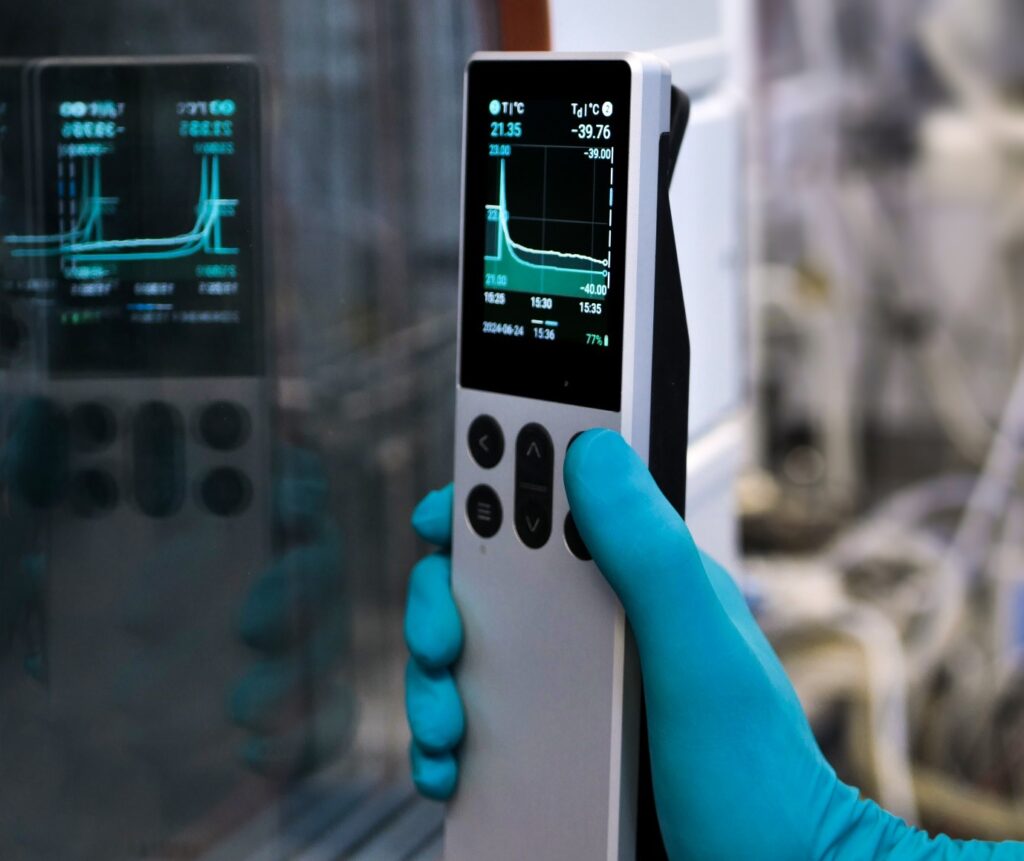Measuring humidity – with precision
The climate crisis is driving demand for the electrification of transportation and energy infrastructure, which in turn is accelerating the need for more powerful and safer rechargeable batteries, including li-ion, sodium-ion and solid-state. However, one of the key issues affecting battery quality is accurate humidity monitoring and dry control during manufacture, and in the following article, Antti Viitanen of Vaisala addresses the issue…

The manufacturing of batteries is a delicate process performed in a highly controlled, ultra-low-humidity environment. Stable, accurate, fast-response dew point probes are, therefore, an essential component of control systems that help improve safety, yields and energy efficiency.
The midstream stage of battery manufacturing involves electrode production, cell assembly and cell finalisation. It is during these steps – in dry rooms, dry booths and glove boxes – that humidity control is especially important to prevent unwanted reactions. These include lithium forming lithium hydroxide and hydrogen gas, lithium salt forming hydrogen fluoride (HF), and electrolyte generating corrosive byproducts. Efficient and effective drying ensures:
- Protection of people and materials, because the chemicals used are sensitive to moisture and present an explosion risk, if exposed to elevated moisture levels
- Yield maximisation whilst maintaining product quality, because excessive moisture negatively impacts the quality and, therefore, the lifetime of batteries
- Energy optimisation by maintaining dry room ambient dryness at optimal levels. This avoids over-drying and under-drying, both of which are extremely costly
Dew-point measurement in solid state battery manufacturing
The ambient dew-point temperature in dry rooms is typically maintained within the range starting from -30 degrees C to -40 degrees C, and these low humidity levels are controlled by high-end dryers. This is one of the most energy-intensive parts of the battery manufacturing process, so minimising over-drying is key to the plant’s overall energy efficiency.
The dew-point sensors in the dryer need to be highly responsive to control the dryer quickly and accurately, but it is important to note that sensor accuracy is not the only factor affecting drying efficiency. A probe with a fast response time, and without the complex internal measurement control loops of some analysers, makes all the difference in dryer and overall dry room control. The volume of air being dried and pushed through the process is very large, so energy consumption can easily skyrocket if the drying process is not optimised.
Newer technologies, such as all solid-state batteries, may require drier conditions with the dew-point temperature as low as -80 degrees C in individual processing steps. Typically, these steps are performed inside dry booths or glove boxes, because it is not usually economically viable to dry the whole dry room to the same extremely low dew-point level. Humidity levels in dry booths and glove boxes are, therefore, monitored at critical points.
Today, the most commonly used measurement device for dryer monitoring and control is a dew-point sensor, based on thin-film polymer technology. Previous instrumentation suffered from drift, especially at low humidity levels, but recent developments have enabled accurate, stable and fast-response dew-point measurement with minimum drift.
Maintaining accuracy in dew-point sensors
Battery manufacturers use large numbers of sensors throughout their processes to measure, monitor and control humidity levels. The cost of these sensors is negligible in comparison with the value of the assets and products that they protect. Nevertheless, it is vitally important that sensors are accurate and stable in the long term, so it is important to select the right sensors, and to implement an effective programme of calibration checks.
A key factor in choosing dew-point sensors is the availability of proven reliability. This means that the providers of sensors should be able to demonstrate long-term accuracy and stability over many years, and in a wide variety of changing environments.
All sensors may deliver measurement results outside of acceptable limits for a number of reasons that may not be immediately apparent. The most important function of calibration is, therefore, to check results against a known standard. However, all measurement devices drift over time to a greater or lesser degree, so ensuring these sensors are properly calibrated at appropriate intervals is essential, if their readings are to be reliable in the long term.
The dew-point sensors used in the midstream processes of battery production are sensitive and highly accurate instruments, but calibration is necessary for more than just the avoidance of drift. For example, the accuracy of sensors can be compromised by physical damage or other environmental factors.

Calibration programmes for dew-point sensors
A variety of calibration options exist for dew-point sensors at battery manufacturing facilities. Handheld devices are available for quick and convenient spot-checking and on-site calibration. The advantage of this method is that probes do not need to be removed from the process, and downtime can be kept to a minimum. In addition, some devices can be used as a reference probe and sent for factory calibration – complete with a certificate for full calibration traceability.
Some sensor manufacturers operate accredited service centres, to which swapped-out sensors can be sent for routine calibration checks. Alternatively, many battery manufacturers find it more convenient and economical to contract their sensor supplier to provide a fixed price calibration programme.
Summary
The purpose of this article is to highlight the potentially serious implications of failing to implement an effective humidity measurement programme in battery manufacturing plants. Dew-point sensors perform a critically important role, so it is vitally important to install the right sensors and to ensure that they deliver stable, long-term accuracy and reliability. To achieve this, no matter which sensor is deployed, an effective calibration routine is essential for the efficient, sustainable operation of the plant, protecting safety, energy efficiency and battery product quality.
The writer is Senior Product Manager with Vaisala. He may be contacted at <emea.media@vaisala.com>.

